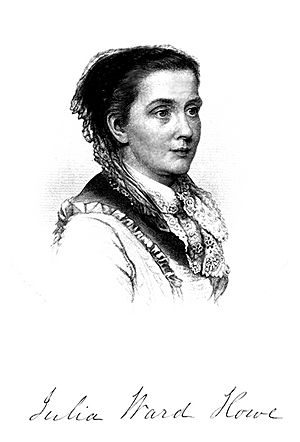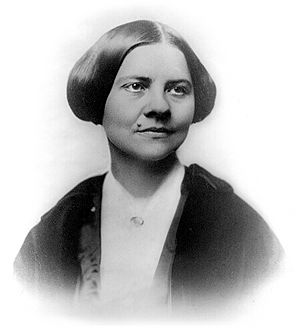New England Woman Suffrage Association facts for kids
The New England Woman Suffrage Association (NEWSA) was a group formed in November 1868. Its main goal was to help women get the right to vote in the United States. Important leaders included Julia Ward Howe, who was its first president, and Lucy Stone, who later became president. The NEWSA worked until 1920, when women finally gained the right to vote through the Nineteenth Amendment to the U.S. Constitution.

The NEWSA was created during a time when the women's rights movement was facing disagreements. There were also disagreements between some women's rights groups and the abolitionist movement, which worked to end slavery. A big debate was whether African American men should get the right to vote before women.
The NEWSA agreed that African American men should get the vote first. This was different from Susan B. Anthony and Elizabeth Cady Stanton, who believed women and black men should get the vote at the same time. The NEWSA also stayed close to the abolitionist movement and the Republican Party. Stanton and Anthony, however, wanted the women's movement to be more independent.
The NEWSA was the first big political group focused on women's right to vote. It was formed in one region (New England) a few months before two national women's suffrage groups were created: the National Woman Suffrage Association and the American Woman Suffrage Association. The NEWSA helped create the American Woman Suffrage Association and shared many leaders with it.
Contents
Why the NEWSA Was Formed
The New England Woman Suffrage Association (NEWSA) was created when there were disagreements within the women's rights movement. There were also tensions between some women's rights groups and the abolitionist movement. These disagreements had already weakened the American Equal Rights Association. This group was formed in 1866 to fight for equal rights, including voting rights, for all people, no matter their race or gender.
A big question was: should everyone get the right to vote at once, or should African American men get it first? After slavery ended in the U.S. in 1865, the American Anti-Slavery Society said its work wasn't done until African Americans had equal political rights.
By the time NEWSA was founded, many hoped this goal would be met by the proposed Fifteenth Amendment. This amendment would stop states from denying the right to vote based on race. However, it would not stop them from denying the right to vote based on gender. This made it a big point of disagreement within the women's movement.
Some women's rights leaders, like Abby Kelley Foster, supported the amendment. They believed that voting rights for African American men were more urgent than for women. Others, like Susan B. Anthony and Elizabeth Cady Stanton, were against any amendment that would give all men the right to vote but exclude all women. They felt this would create an "aristocracy of sex," making it seem like men were superior.
Lucy Stone, a key leader in the NEWSA, thought women's suffrage was more important than black men's suffrage. However, she still supported the Fifteenth Amendment.
The split also involved different views on the Republican Party. Many women's suffrage leaders had started their activism in the anti-slavery movement. They felt loyal to both that movement and the Republican Party. The Republican Party had led the effort to end slavery in the U.S.
After the close elections of 1868, Republican leaders saw how important it was for African American men to vote. Most of these men were recently freed slaves. Giving them the vote would help protect the victory over slaveholders during the American Civil War (1861–1865). Republicans and their abolitionist friends increasingly saw women's suffrage as something that wouldn't bring as many political benefits. They also thought the campaign for it took away resources needed elsewhere.
Women's rights activists had generally supported the abolitionist movement strongly. They also relied a lot on its resources. Those who moved away from abolitionist and Republican leaders during this time found themselves cut off from support. Sometimes, Republicans were even openly hostile towards them.
Stanton, Anthony, and their friends felt betrayed. They began to criticize the Republican Party and some abolitionist leaders. Olympia Brown, who helped create NEWSA, criticized abolitionist leaders by name. She said, "We must look for our support to new men." Stanton and Anthony upset many by accepting help from George Francis Train. He supported women's rights but was also a wealthy Democrat and openly racist. Other women's suffrage activists, however, continued to support abolitionist leaders and the Republican Party.
The NEWSA's Story
Planning the New Group
Olympia Brown, one of the first ordained women ministers, first suggested creating a women's suffrage group in New England. She wanted an organization that would focus only on getting women the right to vote. She believed that fighting for both women's and African Americans' voting rights, as the American Equal Rights Association had done, made women's suffrage less important. She wanted a group that would focus on a "clear-cut, separate and single question."
Following advice from Abby Kelley Foster, Brown announced a meeting in Boston in May 1868. A large crowd attended. The meeting set up a planning committee led by Caroline Severance. Brown and her idea of focusing on a single issue were pushed aside by the planners. To counter the actions of Susan B. Anthony and Elizabeth Cady Stanton, the committee decided to create a group that supported voting rights for both black people and women. They were okay with black men getting the vote first.
Besides Brown and Severance, other key people in planning the new group included John Neal, Abby Kelley Foster, her husband Stephen Symonds Foster, and Thomas Wentworth Higginson. Many of them had been important in the abolitionist movement. Lucy Stone, a pioneer for women's rights, later became a main leader in the new group. She had not yet moved to Boston from New Jersey, so she wasn't deeply involved in the planning. However, she attended the founding meeting and was chosen for the new group's executive committee.
Starting the NEWSA
The New England Woman Suffrage Association (NEWSA) officially formed on November 19, 1868. This happened during a regional women's rights meeting in Boston, Massachusetts, which became the group's headquarters. Unlike Anthony and Stanton, who were moving away from the Republican Party, the NEWSA planners tried to get Republican support. They even had important Republican politicians, including a U.S. senator, speak at their meeting.
When the NEWSA meeting took place, Congress was thinking about the proposed Fifteenth Amendment. This amendment would stop states from denying the right to vote based on race. But it would not stop them from denying the right to vote based on gender, which many women suffragists had hoped for. (The amendment was approved by Congress in February 1869 and became law in 1870.) At the meeting, Francis Bird, a powerful politician in Massachusetts, said, "Negro suffrage, being a paramount question, would have to be settled before woman suffrage could receive the attention it deserved."
People became more confident that the Fifteenth Amendment would pass. Lucy Stone, who would become a future president of the NEWSA, showed her wish for both women and black men to vote. She surprisingly suggested a resolution asking the Republican Party to "drop its watchword of 'Manhood Suffrage'" and support universal suffrage instead. Even though Frederick Douglass, William Lloyd Garrison, and Frances Harper disagreed, Stone convinced the meeting to approve her idea. However, two months later, when the Fifteenth Amendment was in danger of not passing in Congress, Stone changed her mind. She then said that "Woman must wait for the Negro."
The NEWSA supported the Fifteenth Amendment. They believed that getting all men the right to vote would be a step towards women getting the vote. The part of the women's movement connected to the NEWSA expected the Republican Party to push for women's suffrage after the Fifteenth Amendment was approved. (This expectation did not come true.)
Julia Ward Howe, who wrote "The Battle Hymn of the Republic," was chosen as the NEWSA's first president. She came from a well-known family. Higginson and Stone had recently convinced her to join the women's suffrage movement. During the meeting, Howe said she would not demand voting rights for women until black people had achieved theirs.
What the NEWSA Did
Groups connected to the NEWSA were formed in most New England states. In January 1869, NEWSA supporters started publishing a newspaper called the Woman's Advocate. It was printed from the office of the American Anti-Slavery Society.
The NEWSA waited until voting rights for black people were secure before it started campaigning for women's suffrage nationwide. However, it pushed early on for laws that would give women the right to vote in Washington D.C. and federal territories. Another early effort was collecting 8,000 signatures in 1869. These were for petitions to the Massachusetts legislature supporting women's suffrage in that state. This led to annual public hearings on the issue in the state legislature. In later years, the NEWSA's work included fundraising events, lectures, petitions, and legislative hearings.
The split in the women's movement became official in May 1869. That's when Susan B. Anthony and Elizabeth Cady Stanton created the National Woman Suffrage Association to represent their side. The NEWSA's executive committee responded by planning a rival group called the American Woman Suffrage Association (AWSA). This group was founded in November 1869. Henry Ward Beecher, a famous minister, agreed to be the AWSA's first president. But NEWSA leaders Lucy Stone and Julia Ward Howe played key roles in forming the AWSA and leading it in the years that followed.
Julia Ward Howe was president of the NEWSA until 1877. Lucy Stone was elected president that year and served until she passed away in 1893. Howe was again elected president in 1893 and served until her death in 1910. Alice Stone Blackwell, Lucy Stone's daughter, was president from 1911 until the group stopped existing in 1920. When the Nineteenth Amendment, which gave women the right to vote, was approved in 1920, the NEWSA simply stopped working instead of formally closing down.
See also
- Women's suffrage in the United States
- List of major women's suffrage organizations
- List of suffragists and suffragettes
- List of women's rights organizations
- Timeline of women's suffrage
- Voting rights in the United States


